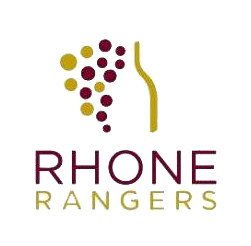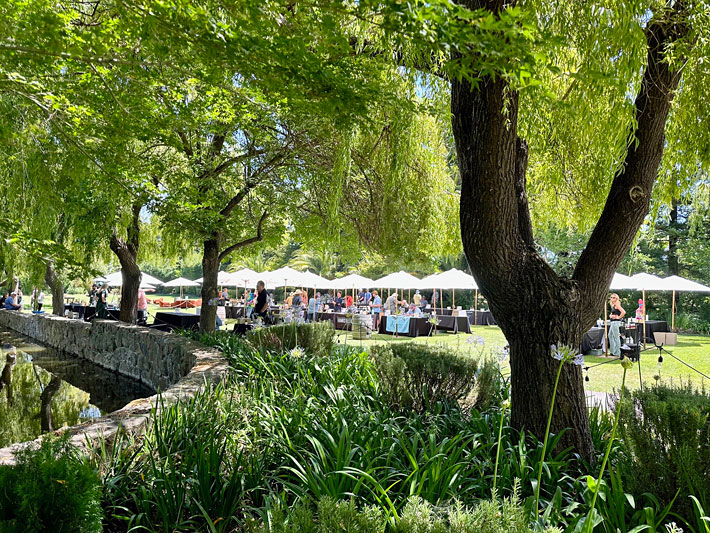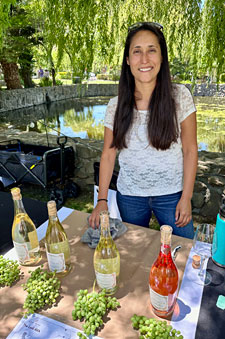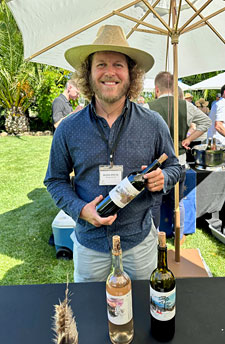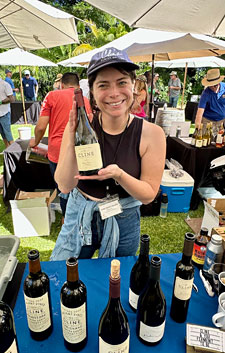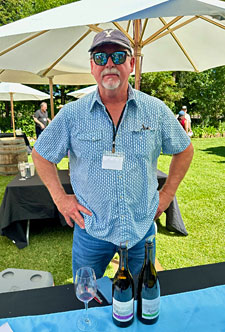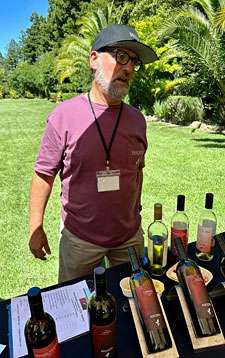Abacela
Earl & Hilda Jones founded Abacela in 1995 in Oregon’s Umpqua Valley. Though particularly known for wines made from Iberian grape varieties, Abacela has worked with Rhône varieties as well for many years. Andrew Wenzl is the Abacela winemaker, and Earl & Hilda’s son Greg – a well-known climatologist – is now the winery CEO. Greg poured the wines at the tasting, and I thought two of the Abacela wines particularly stood out. The 2023 Estate Grenache Rosé had bright strawberry aromas plus of citrus and savory herbal notes, with a vibrant mouthfeel and finish. Aged in 15% new and 85% neutral French oak, the 2019 Estate Reserve South Face Block Syrah was savory and minerally, with dark berry fruit, earth, and spice notes and a hint of flowers, a fairly full-bodied but not heavy texture and fine tannins – this should continue to develop nicely with additional time in the cellar.
Acquiesce Winery
Located in Lodi, Acquiesce was established in 2012 by owner/winemaker Sue Tipton and her husband Rodney. Acquiesce is unique in the Lodi region in that they produce only white and rosé wines, all sourced from their estate vineyard and made entirely in stainless steel tanks. Winemaker Christina Lopez was on hand at the tasting, and all of the wines she poured were very good, with three highlights. Made by the traditional Méthode Champenoise with no dosage, the 2022 Sparkling Clairette Blanche featured bright green apple, citrus, and floral aromas, a broad yet lively mouthfeel, and fine bubbles. The 2023 Picpoul Blanc had intense lemon aromas plus hints of flowers, zippy acidity, and a long, fresh finish. Perhaps my favorite was the 2022 Grenache Rosé, with strawberry, watermelon, and floral notes, fine acidity, and a long, tasty finish.
Belong Wine Co.
Bertus van Zyl and his wife Alli are the team behind Belong, which they started in 2017. The wines are made in Napa, and they work mainly with Rhône grape varieties grown at higher-elevation vineyards in El Dorado County. All of their wines are aged in stainless steel or neutral French oak, and recent reds are entirely whole-cluster fermented. I enjoyed all three of the wines that Bertus poured at the tasting, with two highlights. The 2023 “Chasing the Sunset” Rosé was made from about 50% Mourvèdre and 25% each Cinsault and Grenache with some skin contact prior to pressing, and aged in stainless steel drums. With aromas of bright red fruit, flowers, plus savory and earthy notes, this had a lively texture and finish. The 2019 Mourvèdre was fermented with 75% whole clusters and was plummy, earthy, and savory, with undertones of iron, and had fine structure for continued development.
Cline Family Cellars
Fred and Nancy Cline founded Cline Cellars in 1982, and they moved the winery from Oakley to the Carneros region in 1991. The winery continues to work with fruit from Contra Costa County as well as from their vineyards in Carneros and the Petaluma Gap. Tom Gendall is the director of winemaking and viticulture, and Katie Hoggins is the winemaker. I got to the Cline table at the very end of the tasting and Hilary Cline only had time to pour me two wines but they were both noteworthy. The 2022 “Ancient Vines” Carignane from Contra Costa County featured red fruit, spice, and earth on the nose, with medium body and moderate tannins. Also from Contra Costa, the 2022 “Ancient Vines” Mourvèdre had more of a plummy profile plus lots of spice and a hint of sweet oak, with a bigger texture on the palate and firmer tannins.
Covenant Wines
 |
Established in 2003, Covenant made the move from Napa Valley to their current location in West Berkeley about ten years ago. They make a variety of wines sourced from Napa, Sonoma, Lake, and Santa Barbara counties, Lodi, as well as a small amount of wine from Israel. Winemaker Jonathan Hajdu has worked with Covenant since 2008, and managing director Sagie Kleinlerer poured their wines at the tasting. Two of the wines especially stood out to me. The 2023 “Red C Rosé” was made from Grenache from Mettler Vineyard in Lodi plus some Syrah and Pinot Noir, fermented with native yeast in neutral French oak. This featured strawberry with undertones of citrus and fresh herbs, medium-light bodied with a lively mouthfeel and crisp finish. The 2022 “Landsman” Syrah was sourced from the certified organic Robert Rae Vineyard in Sta. Rita Hills, and also underwent a native fermentation. It had a savory, meaty character, with red fruit, spice, and black pepper in support, medium weight on the palate with firm tannins – very nice now and should benefit from further cellaring.
Kendric Vineyards
Kendric’s Stewart Johnson planted his cool-climate Petaluma Gap vineyard in 2002 – it’s located in northern Marin County. The vineyard is planted mostly to Pinot Noir, along with Chardonnay, Viognier, and Syrah. His family also grows Sangiovese in Amador County’s Shenandoah Valley. The first vintage of the Kendric wines was in 2004, and Stewart makes them on Treasure Island in San Francisco Bay. Their table was one of the last I was able to visit before time ran out on the tasting so I only tried two wines that Stewart poured. The 2022 Viognier from the estate vineyard displayed floral, pear, and stone fruit aromas, with medium-light body and a bright, lively mouthfeel and finish. Stewart also poured a library wine, the 2007 Syrah from Shenandoah Valley – this has developed into a pleasant older red with plum, earth and spice notes and still had a firm structure and finish.
Lindquist Family Wines
 |
Bob Lindquist was one of the earliest of California’s “Rhone Rangers,” and has been making wine on the Central Coast since 1982. In addition to the Lindquist Family Wines label, Bob’s wife Louisa has her own wine label, Verdad, and they work together on wines for their Sawyer Lindquist label. Bob was behind his winery table at the event, and three wines were particular favorites. The 2022 Clairette from Nolan Vineyard in Alisos Canyon had bright pear and stone fruit plus floral notes, with medium-light weight on the palette and a crisp finish. Next was the 2021 Bien Nacido Vineyard Hillside Roussanne, with pear, spice, and herbal aromas plus a richer texture and long finish – this wine should develop more complexity with time in the cellar. The 2021 Bien Nacido Vineyard Z Block Syrah was fermented with 33% whole clusters, and displayed dark berry fruit, savory herbal notes, earth, and pepper on the nose, with medium-full body, a lively texture and firm tannins, another wine that deserves further aging.
Rhônedonnée Wines
Owner/winemaker Aaron Guerrero has worked with some top-notch Central Coast winemakers and launched the Rhônedonnée label in 2017. Aaron sources fruit from a variety of sources in San Luis Obispo and Santa Barbara counties, including from cooler-climate vineyards in the Edna Valley and San Luis Obispo Coast regions. Two of the wines that Aaron poured stood out to me. The 2023 “Trailside Flowers” Roussanne was sourced mostly from Glenrose Vineyard on the Westside of Paso Robles, and includes 5% Grenache Blanc – this had bright stone fruit and floral aromas, medium body, and a long, pleasant finish. The 2021 “Night Ride” Syrah from cool Spanish Springs Vineyard was spicy and savory, with plum and darker berry fruit plus floral undertones, medium weight with fine structure for cellaring.
Ridge Vineyards
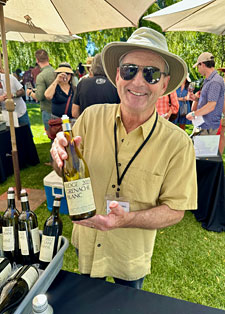 |
The first Ridge wines, made by Dave Bennion, were from 1962, and Paul Draper led the winemaking from 1971 until 2016. John Olney now heads up the winemaking team – Trester Goetting is the winemaker at Monte Bello while Shauna Rosenblum is the winemaker at the Lytton Springs facility. David Gates, who’s in charge of vineyard operations, poured the Ridge wines at the tasting – they were all very good, with three that I thought were particular highlights. The 2023 Grenache Blanc, sourced from Paso Robles, includes 14% Picpoul and 2% Roussanne – this featured bright apple and citrus aromas along with floral undertones and a stony mineral note, medium-light body, and a vibrant finish. Moving to reds, the 2021 “Evangelho” from Contra Costa County, a field blend of 58% Carignane, 22% Zinfandel, and 20% Mataro, showed spicy red berry fruit and earth, with medium weight on the palette and moderate tannins. Even better was the 2022 Buchignani Vineyard Carignane from Alexander Valley, which had earthy red fruit, spice, and pepper aromas, a bigger structure and firm tannins – very nice now but has the potential to really blossom with time in the cellar.
|
Tablas Creek Vineyard
 |
Founded in 1989, Tablas Creek has a 270-acre estate vineyard in the Adelaida District of Paso Robles that was first planted in the early 1990s – it’s now certified for organic, biodynamic, and regenerative organic farming. They purchase fruit from a number of other noted vineyards as well. Jason Haas heads up the winery, while Neil Collins is the longtime winemaker and Jordan Lonborg is the viticulturist. Jason was on hand at the event and poured a fine group of wines. The 2023 “Côtes de Tablas” Blanc is a blend of mostly Viognier and Marsanne, plus Grenache Blanc, Roussanne, and a little Clairette Blanche. This had floral stone fruit and citrus aromas with herbal undertones, medium body, and vibrant acidity on the palette and finish. Sourced from 11 Paso Robles vineyards, the 2023 “Patelin de Tablas” Rosé was made mostly from Grenache, plus Mourvèdre, Vermentino, and a tiny bit of Counoise, and displayed bright and fruit-forward strawberry notes along with floral and citrus scents, medium-light weight with a lively texture. The light-colored 2022 Vaccarèse had red cherry, spice, and dried herb aromas, with medium-light body, a bright mouthfeel, and moderate tannins.
Tercero Wines
Larry Schaffer started his Tercero label with the 2006 vintage and he’s focused on Tercero full-time since 2011. His specialty is wines from Rhône grape varieties, and he sources his fruit exclusively from Santa Barbara County vineyards. All of the Tercero reds are whole-cluster fermented. Larry was on hand to pour his wines at the tasting – he always has quite a few to taste and I had four favorites among them. The 2022 Clairette Blanche featured bright pear and stone fruit along with hints of citrus and flowers, medium-light weight and vibrant acidity. The 2021 Mourvèdre Rosé had savory red fruit aromas along with citrus and spice, with a lively texture and finish. The 2018 Cinsault showed a red fruit and spice profile plus floral and earthy undertones, medium body, and fine tannins. I finished up with the 2015 White Hawk Vineyard Syrah, which displayed ripe dark berry fruit and lots of spice, hints of earth and herbs, medium-full bodied with plenty of structure.
Terre Rouge
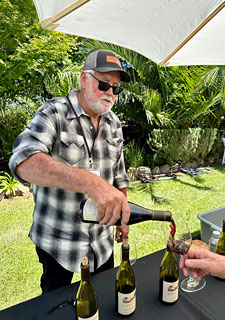 |
Winemaker Bill Easton and his wife Jane O’Riordan run Terre Rouge, which was founded in 1985 – Bill was one of the early Rhone Rangers vintners. The winery is located in Shenandoah Valley in Amador County and most of the Terre Rouge vineyard sources are also from the Sierra Foothills, including several sites that they farm themselves. Bill was behind his winery table at the Rhone Rangers event – I enjoyed all of the wines he poured for me, with three highlights. The 2022 Vin Gris d’Amador, made from about 50% each Grenache and Mourvèdre, was savory and spicy with red berry fruit and citrus notes, medium body, and a lively finish. The 2015 Grenache Blanc from Hawk Creek Vineyard in southern El Dorado showed pear and stone fruit aromas along with the petrol note that the variety often has after some aging, medium weight on the palate with a long finish. I finished with the 2016 Sentinel Oak Vineyard Pyramid Block Syrah from Shenandoah Valley, which featured dark berry and spice aromas, medium-full body, and firm tannins – still youthful, this should continue to develop nicely with further cellaring.
The Language of Yes
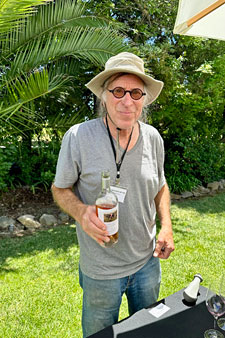 |
One of California’s early Rhone Rangers, Randall Grahm made the first vintage of his Bonny Doon “Le Cigare Volant” Rhône blend in 1984. His most recent project, launched in 2020, is The Language of Yes (La Langue d’Oc), which focuses on wines from Rhône and southwestern French grape varieties, all sourced from Central Coast vineyard sites. Randall was on hand to pour his wines at the tasting – all four that he poured were very good, and I had three favorites. The 2023 “Les Fruits Rouges” Rosé was made from mostly Grenache and Cinsault plus a little Tibouren – this had upfront strawberry, watermelon, and floral aromas, medium-light body, and a crisp finish. The next two wines, both sourced from cool Rancho Réal Vineyard in Santa Maria Valley, were made after several days of air-drying the fruit prior to processing it (passerillage), to help lignify the stems. The 2022 “En Passerillage” Grenache was blended with 4% Syrah, and displayed bright strawberry fruit, spice, and herbal notes, with a very lively mouthfeel and finish. The 2022 “En Passerillage” Syrah, which includes 18% Viognier, had aromas of dark berry fruit, pepper, and spice with floral undertones, medium-full body, and moderate tannins.
The Ojai Vineyard
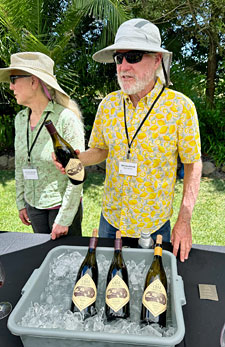 |
After working with some of Santa Barbara County’s pioneering 1970s vintners, Adam Tolmach established his Ojai label in 1983 with the first wines from his estate vineyard in Ojai Valley. Those original vines succumbed to Pierce’s Disease but the vineyard was replanted in 2017. Adam now sources fruit from a number of noted vineyards in Ojai and in Santa Barbara County. Adam poured his wines at the tasting and all four of them were standouts. The 2023 Brick Barn Vineyard Viognier fermented in neutral French oak, and featured stone fruit, citrus, and floral aromas with medium body and a lively finish. Fermented with about 25% whole clusters, the 2022 John Sebastiano Vineyard Grenache had aromas of savory red fruit, earth, and spice, with good acidity and fine tannins. Sourced from Zaca Mesa and three other vineyards, the 2022 Santa Barbara County Syrah was savory and a bit peppery, with plum and darker berry fruit and spice, lighter weight on the palate than most Syrah, and with moderate tannins. I finished with the 2021 Bien Nacido Vineyard Syrah, fermented with 20% whole clusters – with bolder aromas than the previous wine, plus some floral, herbal, and earthy notes, with plenty of structure, this wine really demands time in the cellar but has fine potential.
Troon Vineyard
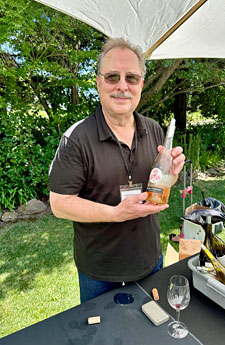 |
Located in southern Oregon’s Applegate Valley, Troon was founded in 1972. Since 2017, the 50-acre vineyard has been gradually replanted with about 20 grape varieties and has received both biodynamic and regenerative organic farming certifications. Garett Long is the director of agriculture and Nate Wall is the winemaker. General manager Craig Camp heads up the team at Troon, and was behind the winery table at the event. I particularly liked three of the wines that Craig poured. The 2022 “Extended Lees Aged” Grenache Blanc was aged for 17 months in neutral oak, and displayed bright apple fruit plus floral, herbal, and stone fruit notes, medium-light body with vibrant acidity and a crisp finish. The 2023 “Glou Glou,” made by carbonic fermentation, is a blend of 62% Cinsault and 38% Grenache – this had upfront strawberry fruit with undertones of flowers and spice, and a bright, fresh mouthfeel and finish. Blended with 25% Grenache, fermented with about 35% whole clusters, and aged for 10 months in amphora, the 2022 “Amphora” Mourvèdre featured plum and red berry fruit, earth, iron, and flowers on the nose, with a lively texture and moderate tannins – this has the potential for further development with more bottle age.
Two Shepherds
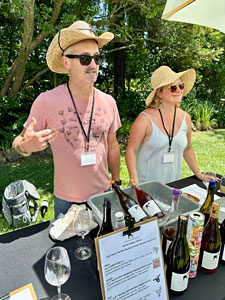 |
Winemaker William Allen established Two Shepherds in 2010 and he was joined by Karen Daenen in 2015. They farm a small estate vineyard in Russian River Valley and buy fruit from many other sites in Sonoma, Mendocino, and Lodi. They make their wines in the town of Windsor in Sonoma County, and produce wines in cans as well as in bottles. Both William and Karen were on hand to pour their wines at the Rhone Rangers tasting – I enjoyed all the wines they poured, with three favorites. The 2021 Vermentino from Windmill Vineyard in Dunnigan Hills, made in 50% each stainless steel and neutral oak, showed stone fruit aromas plus citrus and floral notes, with medium-light body and fine acidity on the palate and finish. Also sourced from Windmill Vineyard, the 2023 “Natty Pets” Sparkling Orange Picpoul is packaged in cans. Made from 75% skin-fermented and 25% direct-press fruit, this was bright and lightly sparkling, with citrus and orangepeel aromas plus a hint of flowers, and a vibrant mouthfeel and finish. I finished with 2021 Grenache from the estate vineyard, fermented with 25% whole clusters and aged in neutral puncheons – this displayed bright red fruit, spice, and earth with brambly undertones, medium body and moderate tannins.
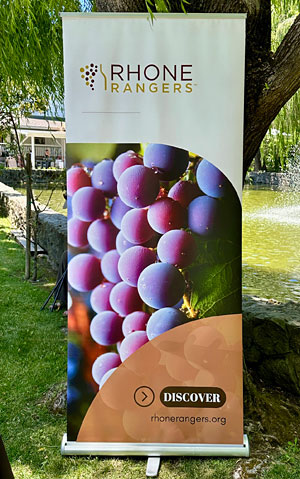 |
|


